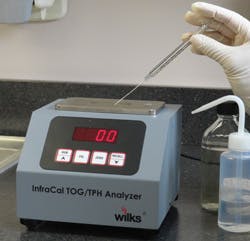Lessons from the Petroleum Industry for Measuring Oil in Water
By Sandra Rintoul
Both the wastewater and the petroleum industries have regulations that limit the amount of oil in discharged water. Despite this fact, there seems to be a divide in communication with regard to oil-in-water testing. In pre-Internet days, an adage among instrument manufacturers was: "Talk to three experts from different companies in the industry, and you will know more than they do -- as they usually don't talk to each other." Today, even with the wealth of online information regarding oil-in-water analysis -- especially as it relates to oil drilling -- the industrial wastewater industry still doesn't appear to talk to the produced water treatment end of the petroleum industry.
Fixed filter infrared (IR) analyzers have been used to test oil levels in produced water on drilling platforms for over 45 years for a number of reasons. On oil rigs where real estate is at a premium, infrared analyzers are compact (typically 6 in., or 15 cm square, weighing less than 5 lbs) and rugged enough to withstand salt air and a rustic lab set up. Further, the operation can be done by non-technical personnel in less than 15 minutes.
Infrared methods also match well with onshore laboratory testing, making IR a reliable way to keep effluent levels under the regulated amount. U.S. EPA methods 418.1 and 413.2 were used extensively worldwide until the Montreal Protocol called for Freon (the solvent used in the analysis) to be phased out. Infrared analysis using tetrachloroethylene (perchloroethylene) for the extraction process is still a regulatory method in the North Sea to ensure compliance with discharge permit levels.
As IR was typically used as a quick verification that oil and grease levels were below the regulated level, other solvents such as tetrachloroethylene, hexane, n-pentane, or S-316 are now widely used on both offshore and onshore oil platforms, even though there is not an associated EPA method for these solvents. There is, however, an ASTM method (D-7066) for infrared oil-in-water analysis using S-316. Trying to perform gas chromatographic or hexane/gravimetric tests on oil drilling platforms is either too time consuming or too complicated. IR is therefore used as a daily check, with a monthly sample typically going onshore for a regulatory test.
For industrial wastewater, the general feeling in the U.S. is that it is necessary to use a regulatory process such as the EPA 1664 method. However, there are situations where a rapid on-site test can be invaluable and even save money and time.
On the industrial side, operators of a pretreatment system using an IR analyzer can easily test how their oil separators work under different loading conditions. A portable infrared analyzer gives a measurement result in less than 15 minutes, providing an operator the necessary information to make adjustments to his or her treatment system to avoid discharging wastewater that is over the regulatory limit.
For the treatment facility that is imposing the limits, an on-site test allows them to catch offenders. While they ultimately require a testing lab to verify the offense, only the samples that are over the limit need further testing. Ideally, most of the samples will be within the limit, saving a significant amount of money and time on laboratory testing. Knowing the concentration level will help avoid a more costly sanitary sewer overflow (SSO) by diverting the effluent loaded with oil and grease, which causes the blockages.
Another advantage of the IR method compared to the hexane/gravimetic method is that 90 percent less hexane is required to the solvent extraction. When using EPA method 1664, a liter sample requires 100 mL of hexane for the extraction. The amount of sample or solvent cannot be reduced with this method, as the weight of the residual oil would be so low, that it would not detect the lower levels of fats, oils and grease. The infrared method only needs a 100 mL sample volume, which requires just 10 mL of hexane for the extraction. This adds up to a significant reduction in per-sample cost.
To avoid time-consuming analyses or costly contracted laboratory tests, the individuals involved in the wastewater industry would benefit to look across the wastewater divide and communicate with the highly-regulated petroleum industry to follow their time-tested, field-proven choice of using infrared analyzers to verify their oil-in-water levels. A lot can be learned from a 45-year track record of providing accurate, reliable oil-in-water measurements.
About the Author: Sandra Rintoul is president of Wilks Enterprise, Inc., which specializes in analyzers for rapid, easy, on-site oil and grease measurements. She also chaired the ASTM committee for Method D 7066 for oil and grease analysis by infrared determination.



